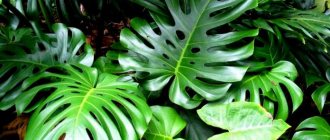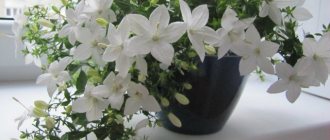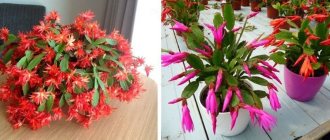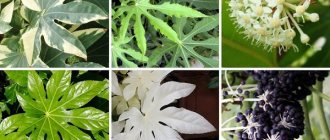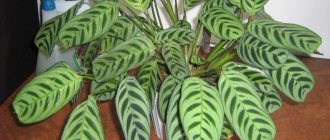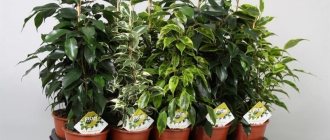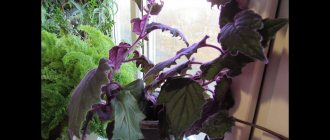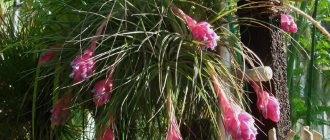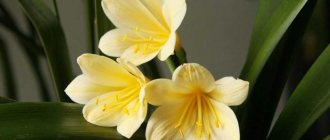Nowadays, plants of unusual colors, especially red, are gaining popularity, and we are not talking about the color of the flowers themselves. Plants with red leaves look fresh, bright, beautiful, interesting, they can charm at first sight and decorate any room. By the way, the red color appears due to anthocyanin pigments. There are a lot of ideas on how to decorate your home or work space with such plants! You can make a green corner by immediately combining different crops with green and red foliage, or create a simpler composition, or you can simply put one bright specimen in a prominent place.
Poinsettia
The beautiful poinsettia is also called Euphorbia most beautiful, Christmas star. A bright representative of the Euphorbiaceae. The most beautiful euphorbia is loved for its unpretentiousness and longevity - it is literally capable of delighting with its beauty for many years, requiring in return minimal but regular care.
Conditions for growing beautiful milkweed:
- Temperature: in summer about +20-25°C, in winter - about +16.
- Lighting: full, a south or south-east window is suitable.
- Watering: moderate, about 2 times in 7 days, in cold weather - 1 time in 3-4 weeks.
- Air humidity: normal, spraying with water is welcome, poinsettia can withstand dry air, but it has a bad effect on decorativeness.
- Pests: scale insects, spider mites, thrips.
- Reproduction: by apical stem cuttings.
What is the name of the Christmas star: Poinsettia flower
Red Leaf Flower Christmas Star
The Christmas Star plant is called Poinsettia . Such bright inflorescences have several other names:
- Latin - Euphorbia pulcherrima.
- Systematic - Beautiful spurge , from the genus Euphorbia , family Euphorbiaceae.
- Christmas star or Star of Bethlehem - the shrub received this name because the flowering period coincides with the Christmas holidays and, in addition, the bracts resemble a star.
- It is also called Holy Night Flower .
- In Chile it is called the Crown of the Andes , and in Spain the Easter Flower .
This is a very interesting flower that can bloom not only with red petals. Read on.
Caladium
Thanks to its leaves, caladium looks more like some kind of extraterrestrial plant. It is distinguished by a combination of interesting colors and colorful veins.
Conditions for keeping and caring for caladium:
- Temperature: in summer - 20-25, in winter - 15-19.
- Lighting: grown in bright places that are protected from direct sunlight, comfortable on an east or north-west window.
- Watering: moderate, when adding moisture, do not allow water to get on the leaves, stops in winter.
- Humidity: high, regular spraying of the soil surface is recommended.
- Reproduction: daughter tubers.
- Pests: aphids, mealybugs.
- Feature of the culture: in the fall the leaves begin to die and in the winter the caladium is dormant.
Codeium
- It is very rare to encounter codiaum in an ordinary high-rise building, since the ornamental plant is very whimsical and the dry apartment air is clearly not to its taste. But greenhouse conditions are very favorable for the flower.
- Codiaum is a representative of the Euphorbiaceae family. The height of a bush under natural conditions can exceed 2 - 3 meters, but when grown artificially, these data can be safely divided by 2.
The most interesting species is considered to be the variegated codiaum with all its varietal differences:
- The color of the foliage of the bush will depend on the variety. You can find leaves not only with red, but also with yellow, orange and even white spots that become brighter as the flower ages.
- The veins are always clearly expressed in a different shade, which makes the leaf blades even more interesting.
Features of care
- As mentioned, Codiaum loves good lighting, but direct sunlight will negatively affect both the leaves and their color (the leaves curl and become brownish).
- Particular attention is paid to watering the ornamental plant, since the flower really needs moisture, which is difficult to maintain. You can get out of the situation by placing the pot on a tray with wet pebbles.
- During the flowering period, you need to ensure that the soil always remains moist and additionally spray the foliage.
Aglaonema
The evergreen exotic is a member of the Araceae or Aronicaceae family. Grows well in regular substrate and hydroponics.
Conditions for aglaonema:
- Temperature: in the warm period - 20-25 degrees, in the cold - 16-18, but not lower.
- Lighting: full, but diffuse, south-west or south-east windows are suitable.
- Watering: plentiful in the summer, reduced later, but you need to make sure that the soil in the pot never completely dries out.
- Humidity: high, requires spraying with warm water.
- Reproduction: seeds, apical cuttings, suckers, dividing the bush.
- Pests: spider mites, mealybugs.
Flowering and pruning of the plant
The Christmas star flower got its name because of its absolutely wonderful inflorescence.
, which in its entirety resembles a chic decoration. But the plant will give such flowers only if it is properly cared for.
Starting in October, the plant's daylight hours are reduced to 10 hours.
To do this, it is placed in a box or covered with a dark cloth on top.
With the onset of winter, the bush must be placed in a warm place
and provide it with bright lighting, as well as provide the plant with abundant watering.
Your Christmas Star
may bloom by the end of December, provided that you have fulfilled all the requirements correctly. You will be able to enjoy amazing beautiful flowers until spring.
Perhaps the leaves of the flower may begin to fall off. This is due to temperature changes in the room, excess moisture in the ground or drafts. Try to protect your plant from these unpleasant factors.
The Christmas star is pruned immediately after flowering.
You need to trim exactly half of the plant. Shoots approximately 15 cm in length should be left.
After you transplant the plant into a new pot, you should trim off all weak shoots.
Some Poinsettia branches that stand out from the total number are pruned during the growing season. Uneven or too long shoots are removed in order to maintain the shape of the bush.
Cordilina
Cordyline leaves are highly decorative. Representative of the Sparzhevs. The crop can be grown in soil or hydroponically.
Features of growing Cordyline:
- Temperature: in summer - 20-25 degrees, in cold weather - not lower than 18, should be protected from drafts.
- Lighting: A bright place is suitable for variegated cordylines, but direct sunlight should be completely excluded.
- Watering: in summer, moisture should be added abundantly, avoiding drying out or waterlogging of the earthen clod; later they are reduced, but you should also not allow the soil to dry out.
- Air humidity: high, regular spraying is recommended.
- Reproduction: through seeds, division of rhizomes, cuttings.
- Pests: aphids, thrips, scale insects.
Names and descriptions of indoor flowers with red leaves at the top
The red leaves at the top of the flower look especially impressive.
Neoregelia
A popular houseplant with colorful leaves is Neoregelia. The flower got its name in honor of the botanist Regel. Externally, it is a tightly assembled rosette of thin leaves. The width is about 5 cm, the height is up to 30-40 cm.
Flower with red leaves
Important! The flower does not always have a constant color. During the dormant period, the core of the rosette is green. Before flowering, the middle of the flower acquires a bright color: from scarlet to pink.
Neorgelia is an epiphytic flower and under natural conditions can grow on different surfaces: both in the soil and on a tree trunk. Therefore, homemade nonorgelias are often grown using the hydroponics method, that is, in a water composition without planting in the soil.
Neoregelia
Poinsettia
An indoor flower with red leaves at the top is poinsettia. Scarlet leaves form a kind of bright “flower” that frames the inflorescence. The edge of the sheet may be bordered by a beige or white thin stripe. Active vegetation occurs during the cold season, flowering occurs at the beginning of January, which is why this plant is also called the “Christmas star.”
The plant is a little picky when it comes to care. Poinsettia loves light, but does not tolerate direct sunlight, because there is a high risk of burns. For normal growing season, the air temperature in the room should be at least 16-17 °C, watering should be moderate.
Poinsettia
Guzmania
Guzmania has a brightly colored inflorescence - the part that frames the inflorescence. The inflorescence is at least 5 cm long. The dense leaves of guzmania form a neat rosette. The color of the leaves below is bright green. The top of the plant (inflorescence) is brightly colored. The inflorescence can be red, yellow, or orange. The flowers themselves are light and inconspicuous. Flowering lasts up to 3 months.
Note! The root system of guzmania is poorly developed, so it is better not to add hard substrate and stones to the soil.
Guzmania also requires periodic feeding with mineral fertilizers.
Guzmania
Coleus
Coleus has two strong advantages: firstly, it is unpretentious, and secondly, it is very colorful and beautiful. Many of them have interesting colors - green borders around the edges and a mottled middle. Representative of the Lamiaceae (or Lamiaceae).
In order for Coleus to please its beauty, it is necessary to satisfy its requirements:
- Temperature: in summer +18-20°C, in winter +12-14, not lower.
- Lighting: for maximum decorativeness, the crop requires full lighting, but direct exposure to rays should not be allowed, the light must be diffused.
- Watering: in spring and summer, abundantly when the top layer of soil in the pot dries, in the cold period it is reduced, but the soil should not be allowed to dry out.
- Air humidity: high, spraying will be beneficial.
- Pests: whitefly, spider mites, aphids.
- Reproduction: cuttings, less often seeds.
Recommendations for owners of unusual indoor crops
Those who want to purchase an unusual houseplant with bright purple, pinkish-scarlet or red-green leaves should first learn the basic rules for choosing them in the store and maintaining them at home. Such ornamental crops require special lighting and are often affected by pests and diseases if not properly cared for. You will have to especially carefully inspect a store-bought flower intended for a gift in order to buy a healthy specimen without damage to the foliage.
Here are some practical tips for beginners and experienced flower growers who have decided to diversify the list of living crops available in the apartment with new varieties of unusual red color.
- When studying the selected variety in the store, you must inspect the flower under the cellophane film for the absence of insect pests, dark spots, yellowing of the tips and other damage. It is better to ask the seller to remove the packaging, if any, and check the leaves for elasticity and the soil for moisture. If there are signs of rot or loss of brightness or decorativeness of the foliage, you should abandon the purchase immediately.
- Having brought the selected specimen home, you need to place it in “quarantine” for a while, placing it away from other plants. After a week, you will have to replant the flower, changing the pot to a larger one, and the soil to a nutrient substrate.
- Do not overwater or dry out the soil in the pot, put the container in a dark place or place it in direct sunlight. Any mistakes in care will lead to loss of decorativeness, leaving stains and burns on the leaves.
Oxalis (Oxalis)
Oxalis, oxalis, lucky clover, sour clover, hare cabbage - these are different names for the same plant. By the way, such names were chosen for a reason; the leaves of the representative of the Kislichny family are really sour. Flower growers are very fond of this crop for its colorful and delicate leaves that resemble butterflies. Oxalis is exactly the case when not only the color, but also the shape of the leaves causes admiration.
Some nuances that are important to know for successfully growing sorrel at home:
- Temperature: in summer 20-25, in winter - 16-18.
- Lighting: bright, but always diffused; direct rays can cause burns.
- Watering: plentiful, but the drainage system must be of very high quality, excess moisture is critical for it, during cold periods the amount of water decreases, you just need to maintain light moisture in the substrate.
- Humidity: moderate to slightly higher than normal room humidity.
- Pests: scale insects, aphids.
- Reproduction: by nodules or daughter bulbs.
Kislitsa
- Translated from Latin, “oxys” means sour, which became the idea for the name of the houseplant. Oxalis leaves actually have a characteristic sourness, since their composition is rich in oxalic acid salts.
- In addition, the components of the leaves include carotenes and vitamin B, which is why the ornamental plant is also used in cooking.
- Oxalis is a flowering perennial plant, among the 800 species of which there are trees and shrubs and indoor varieties of herbaceous flowers.
The most interesting and extraordinary representative is considered to be the purple sorrel. It is this species that pleases the eye not only with its long flowering, but also with its original color and shape of the leaf blades.
Visually, the leaves are similar to clover, but only three triangular purple leaves are attached to the stem. The color itself resembles sparsely scattered blooming crumbs of purple, pink, white or red.
Features of care
- Purple oxalis loves light, but for comfort the plants are placed in partial shade.
- However, during the flowering period, the location of the pot will need to be changed to a lighter one.
- The room should be cool, as the sorrel tree does not tolerate excessive heat.
- If the heat and light conditions are not observed, the plants stop blooming, and the leaves dry out and curl.
Nidularium
Attractive because of its glossy, shiny, dense leaves. The highlight of nidularium is given by the bracts, colored red. Refers to Bromeliads.
The following conditions are suitable for decorative deciduous plants:
- Temperature: in warm weather +20-24°C, in cold weather +18-20.
- Lighting: partial shade, strong shadow and direct sunlight are not allowed.
- Watering: moderate, waterlogging should not be allowed; moisture should be added when the soil dries out. In spring and summer, it is recommended to add moisture through the leaf funnel, and in the cold period - in the standard way.
- Humidity: normal room humidity, in dry air you need to spray the leaves.
- Pests: scale insects, mealybugs.
- Reproduction: daughter rosettes.
Bromeliads
This family includes more than 3,000 species. Bromeliads are herbaceous or shrubby perennials. They are distinguished by shortened stems, the leaves are usually grouped into bunches or rosettes. In their natural environment, they are predominantly found in America, and only one species of bromeliad can be found in West Africa.
Cryptanthus
A stemless evergreen plant with green and red leaves collected in a dense rosette. This flower is also called “earth star” - pointed leaf plates arranged in a circle look like a star. It grows naturally in Brazil.
The flowers are inconspicuous, hidden in the depths of the rosette. The foliage is colored in rich shades of red, brown, green, white, yellow or pink, depending on the variety. For indoor maintenance, species with wavy, striped or patterned leaves are often chosen. This tropical plant loves warmth and does not tolerate lack of watering and cold drafts. It constantly needs high levels of humidity.
Neoregelia
An epiphytic or terrestrial plant, it grows naturally in the humid tropics of Peru, Colombia, and Brazil. The leaves are narrow, long, collected in dense rosettes. There may be spikes or teeth along the edge. The center of the rosette is painted in different shades - from pink to burgundy. Small, almost invisible flowers are hidden in the axils of the bracts and have a racemose shape. During flowering, the inside of the rosette or the ends of the leaves turn bright red.
Nidularium
One of the brightest light-loving plants in the bromeliad family. The dark green leaves, located in the center of a large rosette, turn yellow-red during flowering. There are varieties in which the central part is raspberry, burgundy or scarlet. Nidularium blooms from April to December and is resistant to temperature changes and lighting levels.
The plant grows quickly, forming dense cushions of several dozen specimens. In the wild, there are 20 species that differ in the color of the inflorescences, but are similar in the shape of the foliage. Eight varieties are grown indoors.
Croton (Codiaeum)
Croton has attractive leaves. The codiaum flower is not particularly decorative; it is often simply torn off so that it does not take away excess energy. A representative of the Euphorbiaceae family has a truly fantastic color, combining several colors at once: red, yellow, green, pink, orange. This amazing combination will appeal to lovers of picturesque and rich colors. Codiaum also has an interesting feature - milky sap in the stems and leaves.
However, croton is demanding in care; it cannot be called unpretentious and unpretentious:
- Temperature: in summer +20-23, in winter +17-18, t should not fall below 17 degrees. It is also important to avoid any drafts.
- Watering: abundant in spring and summer, perform the procedure when the top layer of soil dries 1 centimeter. In winter, the introduction of moisture is reduced.
- Air humidity: high, it is necessary to regularly spray the leaves and clean them of dust.
- Lighting: should be full, but should be protected from direct rays. Therefore, it is better to place the pot on the east or west side.
- Pests: rarely affect due to the poisonous sap, but under unfavorable conditions (dry air) scale insects are possible.
- Reproduction: apical cuttings, air layering.
Croton
Croton is another plant from the spurge family; many professional gardeners recognize it as one of the most attractive decorative foliage flowers. The main advantage can be called a worthy decoration of virtually any interior without the need to allocate significant space for it.
All the features of caring for croton are discussed below:
- The plant responds positively to bright light, but is very sensitive to an excess of sunlight , so in summer it is best placed on the north side, and in winter it is moved to the south. This will allow him to sunbathe exclusively in the morning and evening hours.
- The optimal temperature in summer is +20 – +22°C, and in winter at least +16°C.
- Watering must be done regularly so that the soil is always moist , but excess moisture must also be avoided, otherwise there is a risk of rotting of the root system.
- Ambient humidity is very important for croton; it grows poorly in rooms with dry air. To create the most comfortable conditions, it is recommended to spray daily from a spray bottle.
- Special requirements are imposed on the water that will be used for irrigation: it must be warm enough, it must first be subjected to a filtration procedure or settled, which will help get rid of a number of harmful impurities.
- In the summer, the croton needs to take a warm shower every month , but during this procedure it is necessary to ensure that water does not flow inside the pot, as this will lead to waterlogging of the soil.
- For fertilizing, a complex solution of various mineral fertilizers is used, which are applied only to pre-moistened soil. From mid-spring to late autumn, the procedure is carried out twice a month; in winter, it can be reduced to 1 feeding every month.
- As they grow, mature plants must be pruned so that they form a beautiful crown of the correct shape. All sections must be treated with sulfur powder or a charcoal mixture. This is necessary for faster healing of wounds and minimizing the risk of infection.
- Young plants are not pruned, but they must be pinched. You can start doing this from the moment the croton grows to 15 cm in height.
- If flowering does not represent any decorative value , then all young buds should be cut off in a timely manner, since this process takes a significant amount of energy from the croton.
Irezine
The compact bush amazes with its lush and colorful beauty. The variegated leaves are painted in an attractive beet red color.
Features of growing irezine at home:
- Temperature: in the warm period - 19-25 degrees, in the cold - 15-18.
- Lighting: the light-loving crop prefers full lighting; on a south window it is recommended to make it diffused.
- Watering: abundant (when the top layer of the substrate dries out), reduced in winter, but do not allow the soil to dry out.
- Humidity: normal, periodic spraying will be beneficial.
- Pests: aphids, whiteflies.
- Reproduction: stem cuttings.
- Feature of caring for irezine: you should periodically pinch the tops of the shoots to form a beautiful bush.
Tips for flower growers
The article examined the main varieties of ornamental plants with red leaves and the features of caring for them. To summarize, the following recommendations can be given to flower growers who decide to grow them:
- When growing poinsettias, special care must be taken as this plant is highly poisonous. When working with it, it is not allowed to touch your eyes or other mucous membranes with your hands; before doing this, your hands must be thoroughly washed with soap.
- Flower growers who do not have a lot of free time are advised to pay attention to oxalis: the plant has an attractive appearance and unusual reddish-purple leaves, but does not require painstaking care.
- The most common is the classic version of croton with variegated red-green leaves, but breeders have developed a number of rarer and more interesting hybrid varieties. You can try to find one of them to decorate your interior; there is no difference in care.
- Columnia is very susceptible to various diseases or parasites, which are eliminated using special chemicals. However, preventive measures can also be taken in the form of ultraviolet treatment; the procedure takes only 2 to 3 minutes and is carried out once a week.
Sources
- https://stroy-podskazka.ru/komnatnye-cvety/s-krasnymi-listyami/
- https://frutisad.ru/puansetiya-tsvetok/
- https://worldorchids.ru/komnatnie-rasteniya/puansettiya.html
- https://superarch.ru/usadba/posadki/czvetok-s-krasno-zelenyimi-listyami
- https://podokonnik.temadnya.com/1730640884258572451/15-komnatnyh-rastenij-s-pestrymi-listyami/
- https://vogorode.com/home/flower/s-krasnymi-listyami.html
- https://moyasotka.com/tsvety/komnatnye
- https://cvetoshki.ru/dekorativno-listvenny-e/tsvety-s-krasny-mi-list-yami-foto-i-nazvaniya.html
- https://greensotka.ru/tsvetushchie/komnatnyj-cvetok-s-krasnymi-listami.html
- https://1pocvetam.ru/komnatnye-rasteniya/cvetok-s-krasnymi-listyami-puansettiya.html
[collapse]
Neoregelia
It is similar to Nidularium, but this is not surprising, because they belong to the Bromeliads. Neoregelia is attractive because of its beautiful glossy leaves and variegated bracts.
The conditions acceptable for neoregelia are simple:
- Temperature range: in summer +21-25°C, in winter - +16-18. It is very important that there is good ventilation and neoregelia has access to fresh air, but it should be protected from drafts.
- Lighting: bright diffused light without direct light.
- Watering: you need to pour water into the rosette of leaves, in winter - under the root.
- Humidity: high, it is recommended to use a humidifier or spray frequently. It is also important to remove dust from the surface of the leaves.
- Pests: aphids, mealybugs, bromeliad scale insects.
- Reproduction: daughter rosettes.
Aroid
There are 3000 species classified as Araceae. These are monocotyledonous plants, found more often in the subtropics, tropics and temperate climate zones. Less than 10 types grow in subarctic regions. The family includes aquatic, marsh and terrestrial herbs, epiphytes and lianas. Some species reach enormous sizes. There are many houseplants in the family with red leaves.
Aglaonema
Variegated home flower with beautiful large leaves. An evergreen herbaceous crop with a short, straight stem that can store moisture. The color of the foliage can be rich green, reddish, or variegated with stripes of silver or white. The leaf blade is lanceolate or ovate, attached to the trunk by short petioles. The inflorescences are a light green or white blanket with a spadix inside.
Under natural conditions, aglaonema grows in southeast Asia and New Guinea and has more than 50 species. The plant prefers high temperature in the room and humidity around.
Caladium purpurea
This tropical giant can reach 5 m in height; at home, the herbaceous perennial grows no higher than 70–80 cm. It is called “elephant ears” for its large, fleshy, heart-shaped purple leaves. In Brazil, it is cultivated as an agricultural crop, extracting starch from the tubers.
The shape of the leaves of all varieties is the same, they differ in color. They can be light or dark green, reddish with streaks on the reverse side, or with whitish stripes. All flower species found in our country are hybrids.
Cryptanthus
Cryptanthus is another striking representative of the Bromeliad family. The color of the leaves will appeal to lovers of unusual color combinations. The pattern also looks interesting.
The nuances of growing cryptanthus:
- Temperature: in summer 21-24 degrees, in winter 18-20, without drafts.
- Lighting: loves sunny, bright areas in the house, but without direct sunlight, very light partial shade is allowed.
- Watering: in spring and summer it is necessary to constantly maintain moderate soil moisture. It is important to avoid excess and lack of moisture. The main thing is stability, without sudden changes. In cold weather, the procedure is performed much less frequently; after the top layer of soil has dried, moisture should be added the next day. Water at the root, do not bring water into the outlet.
- Humidity: Cryptanthus needs high air humidity, which must be maintained constantly. An air humidifier or spraying several times every day will help.
- Pests: spider mites, thrips.
- Reproduction: by lateral shoots.
Christmas star flower: diseases and pests
Christmas star flower: diseases and pests
Poinsettia, like many house plants, is susceptible to diseases. The Christmas star flower and pests can affect it.
- Leaf blades may develop powdery mildew . This occurs at low temperatures and constant and heavy watering. Just in case, for prevention, treat the leaves with phytosporin several times during the growing season.
- Gray rot and fusarium wilt constantly affects the plant. The preventive measures are the same.
- Overwatering the plant too often can cause various root rots. You can fight them with the same phytosporin or another biological product, for example, trichodermin.
There are also a lot of pests. The spider mite is especially dangerous - the enemy of all indoor flowers. It loves dry air, so moisten the space around the flower and the leaves themselves more often with a spray bottle. Thrips, scale insects and whiteflies can attack poinsettias while the green leaves are growing. They are destroyed using special insecticides, which are easy to purchase at any flower shop.
Maranta
An attractive feature of arrowroot is its bright red veins. The combination of scarlet, dark green and light green shades makes this decorative foliage plant stand out. Belongs to the Marantaceae family.
Conditions for growing tropical exotics:
- Temperature: in spring and summer +22-24, in winter and autumn +18-20. Protection from any drafts is important.
- Lighting: bright, but diffused light, but can withstand slight shading.
- Watering: during the warm period, plentiful, it is necessary to maintain moderate soil moisture, and the soil surface should not be allowed to dry out. In winter, the procedure should be performed less frequently; the surface of the top layer of soil should dry out.
- Humidity: high, it is necessary to regularly spray the arrowroot, and it is also useful to periodically clean it in the shower.
- Pests: spider mites.
- Reproduction: by dividing the bush, apical cuttings.
Caring for poinsettia at home
When buying a Christmas star, you need to pay attention to the condition of the flower. Don't buy a plant with limp leaves. Choose a Christmas tree whose inflorescence consists of unopened buds, then it will not lose its decorative effect for a long time. If there is pollen on the stamens of blossoming flowers, the flowering phase will soon end.
The bracts should be brightly colored. Green spots on the bracts indicate that the plant is sick. A healthy Christmas tree is evenly covered with foliage. Do not choose a flower with bare areas on the shoots. Pay attention to the soil in the pot. If the soil is too dry, then the plant is not provided with proper care. The roots of such euphorbia may be weakened.
Air temperature and humidity
When transporting in winter, the Christmas flower must be packed in paper and plastic. The tropical plant cannot tolerate temperatures below 10°C. Euphorbia will bloom for a long time in a warm (t +20-23°C), well-lit room. Do not keep the plant in a draft, under an open window. After flowering, it is transferred to a cool place (+15-16°C). The dormant period of the flower lasts 1.5-2 months.
When new shoots begin to grow, the flower pot with poinsettia is transferred to a warm room. The plant does not like sudden changes in temperature. If the temperature regime is not suitable for the poinsettia, it sheds its leaves. Caring for a Christmas tree consists of constantly maintaining air humidity at 60-70%. So that the Christmas star does not experience discomfort:
- Spray the plant with warm water from a spray bottle every day.
- Place the flower pot on a tray of damp expanded clay. The material quickly accumulates moisture and slowly releases it to the environment.
- Install a household humidifier next to the flower.
- Place the euphorbia in a florarium (a tall vessel with transparent walls).
Location and lighting
In winter, the window sill of southern windows is most suitable for the Christmas star, because during flowering it needs bright but diffused light. On cloudy days, it requires additional lighting with fluorescent or phytolamps. Place a flowerpot with a flower on the windowsill so that the leaves do not touch the glass.
In summer, protect euphorbia from direct sunlight. The culture feels good in the open air of shaded balconies and loggias. The Star of Bethlehem does not tolerate crowding, so it is better to place other indoor plants away from it.
In order for the Christmas poinsettia flower to bloom before Christmas, it needs to create special lighting conditions. The plant's daylight hours should be no more than 10 hours. 8 weeks before the Christmas holiday, from 17.00 until the morning, cover the flower with a black opaque plastic bag.
Watering
Watering poinsettias
The Christmas star flower requires plenty of watering in the summer. Use only distilled water. Immediately pour out the water from the potting tray. In stagnant water, putrefactive bacteria develop and enter the soil through the drainage hole of the pot. It is recommended to water the plant when the top layer of soil has dried 1-2 cm.
During active growth and flowering, water the plant 2-3 times a week. Over-wetting the soil can cause rotting of the root system. During the dormant period, water the poinsettia moderately, as the soil layer dries 3-4 cm.
The soil
The Christmas star is suitable for ready-made substrate for decorative foliage plants. Soil acidity should be at 5.8-6.6 pH. You can prepare your own soil mixture from turf, leaf soil, peat and river sand (3:2:1:1). First disinfect the soil for the flower by watering it with a 2% solution of potassium permanganate (2 g per 100 ml of water).
Top dressing
Fertilizers for the Christmas star
You need to start fertilizing the Christmas star after a period of rest. Use complex mineral fertilizers for flowering indoor plants such as Agricola, Bion, Etisso. The dosage and method of preparing the fertilizer are indicated in the instructions for use of the drug.
To prepare the Christmas star for flowering, feed the plant with potassium-phosphorus fertilizers from September. For example, in 10 liters of water, dilute 2.5 teaspoons of double superphosphate and potassium nitrate. The regime for applying all fertilizers is once every 2 weeks.
How to prune poinsettia
After flowering, the Christmas tree bracts begin to fall off. When there are no colored leaves left on the branches, prune the poinsettia. If this is not done, the plant will not bloom next winter, because buds form only on young shoots. Features of trimming a Christmas star:
- Do not water the plant 1-2 days before the procedure so that the milkweed does not lose a lot of milky juice.
- Trim the bush at a height of 10 cm from the soil surface with disinfected sharp scissors (secateurs).
- Wait until the release of milky juice stops.
- Water thoroughly, replant the next day and send the flower to rest in a cool place (+15-16°C).
- After 6-8 weeks, young shoots will appear. When they reach 10 cm, select the 5-6 strongest shoots and cut off the rest. If this procedure is not carried out, the poinsettia will not bloom.
- Do not throw away the cut branches, but use them to propagate the flower.
Poinsettia transplant
The process of replanting a Christmas star
Replant the Christmas flower the day after pruning to allow the plant to recover a little from the shock. Choose a pot slightly larger than the previous one. Transplant algorithm:
- Scald a new flower pot with boiling water.
- Fill 1/3 of the container with a drainage layer of expanded clay.
- Gently pull the cut branches and remove the bush from the pot. Lightly shake off the soil. If the root system is intertwined with the earthen lump, leave it as is.
- Inspect the root system. Trim damaged, dry, rotten roots. Sprinkle the sections with crushed activated carbon tablets.
- Pour soil into the pot, filling it halfway.
- Place the plant in the center and fill the container to the brim with soil.
- Gently press down the soil near the stem with your fingers.
- Water thoroughly.
How to propagate poinsettia at home
The Christmas star is easily propagated by cuttings. Harvest them in the spring, when you prune the plant, or in the summer when forming the crown. Poinsettia propagation algorithm:
- Cut the cutting under the shoot node.
- Place them in warm water for 5-10 minutes to drain the milky juice.
- Air dry the cuttings for 2 hours.
- Powder the sections with Kornevin to activate root formation.
- Fill the container (wall height 7-10 cm) with a soil mixture of peat and sand, taken in a 1:1 ratio.
- Plant the cuttings, deepening them by 1-2 cm.
- Cover them with a cut plastic bottle.
- Place the container in a warm (20-25°C), well-lit place.
- Regularly water, spray and ventilate the plantings.
- After rooting (after 3 weeks), transplant the sprouts into permanent pots.
- Pinch the tops of the cuttings to form side shoots.
Begonia royal
The plant is also called Begonia Rex. It blooms rather inconspicuously, so flowering cannot be called the main trump card of a representative of the Begoniev family. The main beauty of the royal begonia is its variegated and luxurious leaves.
- Temperature: about 19-22 degrees, in winter - about 16.
- Lighting: bright, but the sunlight must be diffused; direct rays can cause burns to the foliage.
- Watering: abundant, you need to add moisture immediately when the top layer dries.
- Air humidity: normal or very slightly increased.
- Pests: thrips.
- Reproduction: through seeds, cuttings, division of the root system.
Varieties: description and photo
Thanks to the painstaking work of breeders, red-fire poinsettia has acquired many new varieties. Below are photos and a description of the most popular ones.
Premium Red
This variety can be considered a true embodiment of the Christmas star. The classic bright red color of the broadly lanceolate, pointed bracts matches perfectly with the greenish-yellow core.
Cortez Burgundy
It can be called an ideal variety for lovers of rich colors and traditionally laconic forms. Breeders developed a whole series of this variety of poinsettia, dedicating it to the conqueror of Mexico, Fernand Cortez.
Attention. Cortez Burgundy looks incredibly solemn and bright, thanks to the purple apical stipules.
Cortez Red
It is an equally attractive representative of this series. Its fiery scarlet bracts acquire dark green veins as the shoot develops.
Winter Rose
It is one of the first representatives of the species to have “double” leaves. Textured, intricately curved bracts transform the appearance of poinsettia, making it similar to a rose. Its greenish center is bordered by a luxurious rosette of fireplace leaves.
Winter Rose Early Red
Also incredibly similar to the queen of flowers. And its solemn red apical leaves will appeal to even the most demanding gardeners.
Strawberry and cream
It has coral-red foliage with small soft white spots.
Reference. The leaves of the “marbled” poinsettia Strawberry and cream are intricately cut, which makes them similar to the green mass of American oak.
Tapestry
This variety is endowed with bright scarlet bracts. But the leaves located down the shoot are decorated along the edge with an uneven yellow edging.
Carousel Dark Red
This variety stands out among others due to the unusual shape of its bract petals. Their edges seem to be curled, which is characteristic of only 2 varieties of poinsettia. Dark scarlet petals harmonize with modest greenish inflorescences.
Premium Ice Crysta
Can be called the most gentle representative of the Christmas star. Its pointed, heart-shaped leaves, located near a small green inflorescence, are distinguished by a bright scarlet color, reminiscent of a blush.
Jingle Bells
The variegated bracts of this variety of poinsettia seem to be dusted with light snow. And the fireplace-red leaves create a true pre-holiday mood.
Sonora White Glitter
A bright flower, reminiscent of festive fireworks, with white splashes on the fireplace leaves, looks very contrasting against the background of a dark green or purple edging.
Hypoestes
Hypoestes belongs to the Acanthus family, it will decorate and enliven the decor of any room. Variegated leaves will appeal to lovers of variegated and unusual colors and patterns.
Features of hypoestes:
- Temperature: in spring and summer +22-25°C, in winter +17-18.
- Lighting: bright diffused.
- Watering: in warm weather, abundant when the top layer of soil dries. In winter, add moisture 1-2 times after the top layer of soil dries.
- Air humidity: high, spraying recommended.
- Pests: not susceptible.
- Reproduction: cuttings, through seeds.
As you know, red is the color of wealth and prosperity; it is believed that its presence in the house can attract success. It is possible that such thoughts have no basis in reality, but it is a reality, not a fiction, that color therapy works and with regular visual contact a person’s mood improves. Looking at a variegated houseplant with a red tint, you can lift your spirits, and a good mood - the key to good health.
House flowers with red spots or stripes on the leaves
Spotted and striped foliage looks bright and unusual. This plant will add variety to your home flower garden.
Hypestes
What is the name of an indoor flower with long narrow leaves?
Hypestes is an indoor plant with red-green leaves. The color of the foliage is uneven, spotted. The flower has thin stems with oval leaves. The color of the plant may change depending on the lighting; with a lack of sunlight, the red spots disappear.
The flower does not like heavy soils; a mixture of compost, peat, river sand and leaf soil (1:1:1:1) is suitable for it. To maintain splendor and prevent the stems from stretching too much, you need to periodically cut off the shoots that form at the crown. The normal height of the stems is considered to be 30-60 cm.
Important! Since hyposthes is a tropical species, it needs additional mineral supplements.
Hypestes
Irezine
The irezine flower is distinguished by brightly colored veins: red, crimson or pink. Young leaves are green, but as they develop they turn red or brown, the veins remaining red. Thanks to this feature, the leaves look striped. The shape of the leaf plate is elliptical, oblong with a pointed end. Irezine is a bush flower, so its stems are quite dense and erect.
Irezine is demanding on water; it is better to use rainwater for irrigation. In spring, the flower requires frequent fertilizing with mineral fertilizers at weekly intervals. Dried leaves of a flower must be cut off to maintain density.
Irezine
Aglaonema
Aglaonema is distinguished by leathery, shiny leaves with a red streak in the center. The veins that extend from the central one create thin yellow-green stripes. The leaf shape is oblong-lanceolate, pointed. Young leaves are colored light green; as they grow, they darken and turn red. The average height of the plant is about 35 cm.
Normal vegetation occurs at low temperatures, about 20 °C. During the period of active growth (spring-autumn), it is recommended to water about 3-4 times a week. In winter, watering is reduced, and with the onset of spring, in order to awaken the flower, you need to water it more often with warm water and feed it with mineral fertilizers.
Aglaonema
Fittonia
Some types of Fittonia have an interesting pattern on the surface of the leaf blade, formed due to bright veins. The flower stems are thin, creeping, no more than 10 cm in height. Typically, inflorescences form at the top of the shoot. Fittonia flowers are not valuable because they are small and inconspicuous. The leaves of the plant are oval with a rounded end. The veins are wide, clearly visible, and bright. The length of the leaf blade is about 6-10 cm, the leaves are largest at the bottom, and smaller at the top.
Important! Fittonia shoots easily spread and attach to the stems and roots of other plants, so you should not place it next to plants that may be damaged by its weaving.
Fittonia is very demanding on lighting. It should not be left in direct sunlight because it will get seriously burned and may even dry out. The best place is the far corner of the room. Temperature is very important for Fittonia; the room should be at least 20 °C. During the period of active growth (from spring to autumn), water it especially abundantly; in winter, watering is reduced, but not completed.
Fittonia
